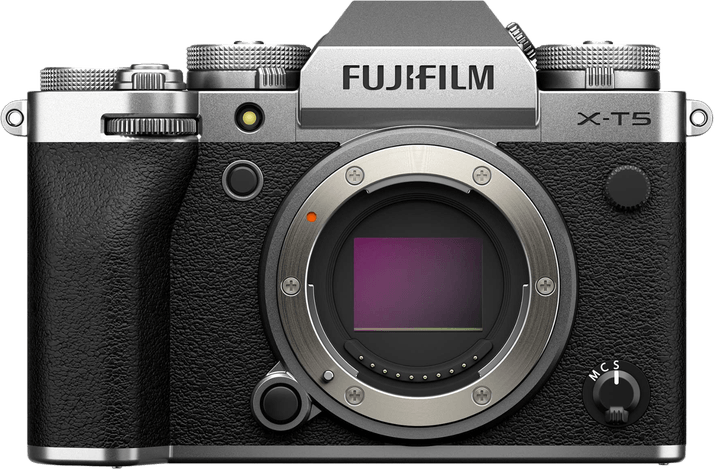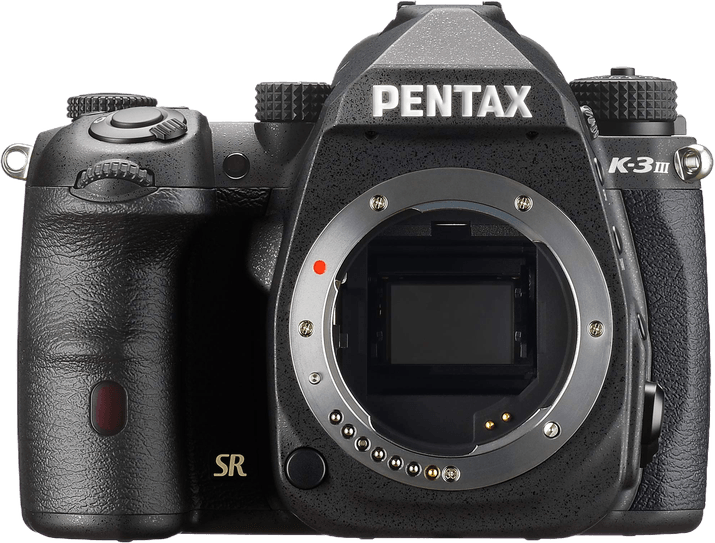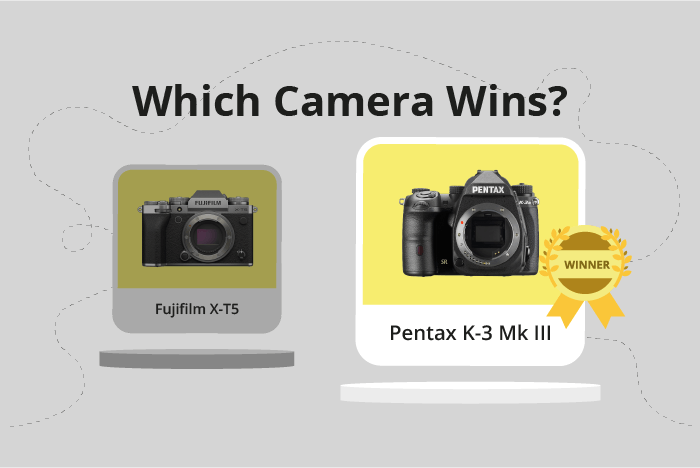Fujifilm X-T5 vs Pentax K-3 Mark III Comparison
Fujifilm X-T5

Pentax K-3 Mark III

The Pentax K-3 Mark III takes the lead with a score of 83/100, just 2 points ahead of the Fujifilm X-T5 at 81/100. Both cameras share similarities, such as being released in 2021 and 2022, respectively. They also differ in their camera types, with the X-T5 being a mirrorless camera and the K-3 Mark III being a DSLR.
The Fujifilm X-T5 has some advantages, including a lower launch price of $1699 and a lighter weight of 557g. This makes it more budget-friendly and portable than the Pentax K-3 Mark III. On the other hand, the Pentax K-3 Mark III offers a higher overall score, which reflects its better performance and features. It is also a bit larger, measuring 135 x 104 x 74mm, and heavier at 820g.
When comparing these two cameras, the Fujifilm X-T5 is a more affordable and lightweight option, while the Pentax K-3 Mark III has a slightly higher score, indicating a better overall camera. Ultimately, the choice between these cameras depends on individual preferences and needs.
Fujifilm X-T5 vs Pentax K-3 Mark III Overview and Optics
The Pentax K-3 Mark III edges out the Fujifilm X-T5 in our optics comparison with a score of 82/100, a narrow one-point lead over the X-T5’s 81/100. Both cameras share several key features, including a CMOS sensor, APS-C sensor size, and image stabilisation. Additionally, they both utilize proprietary lens mounts – the Fujifilm X for the X-T5 and the Pentax KAF2 for the K-3 Mark III.
The Pentax K-3 Mark III has a DXOMARK sensor score of 96, showcasing its strong image quality. Although the Fujifilm X-T5 does not have a DXOMARK score, its 40-megapixel resolution surpasses the K-3 Mark III’s 26 megapixels, resulting in higher image detail. The X-T5 also has a faster shooting speed of 15 frames per second, compared to the K-3 Mark III’s 12 frames per second, making it more suitable for capturing fast-moving subjects.
In terms of processing power, the Fujifilm X-T5 is equipped with the X-Processor 5, while the Pentax K-3 Mark III uses the Prime IV processor. The X-Processor 5 may yield faster performance and better noise reduction, giving the X-T5 an advantage in low-light situations.
On the other hand, the Pentax K-3 Mark III’s DXOMARK score of 96 highlights its excellent sensor quality, which contributes to its overall image quality. This may compensate for its lower resolution and shooting speed when compared to the X-T5.
Taking these factors into account, the Pentax K-3 Mark III’s superior sensor quality and performance justify its higher optics score. However, the Fujifilm X-T5’s higher resolution and faster shooting speed make it a strong contender in its own right. Ultimately, the choice between these two cameras will depend on individual preferences and specific shooting requirements.
Fujifilm X-T5 vs Pentax K-3 Mark III Video Performance
The Fujifilm X-T5 outperforms the Pentax K-3 Mark III in video capabilities, scoring 87/100 compared to the latter’s 83/100. Both cameras share some common specifications, such as a maximum video frame rate of 60fps and built-in time-lapse functionality.
The Fujifilm X-T5 excels in offering a maximum video resolution of 6K and dimensions of 6240×4160, which is significantly higher than the Pentax K-3 Mark III’s 4K resolution and 3840×2160 dimensions. This difference allows the X-T5 to capture more detailed and sharper videos, making it a superior choice for videographers and content creators who require high-quality footage.
While the Pentax K-3 Mark III lags behind in video resolution, it still delivers commendable performance with its 4K capability. This resolution is suitable for most casual users and enthusiasts who do not demand the highest level of detail in their videos. The K-3 Mark III’s performance remains respectable and adequate for a range of video applications.
Comparing the video capabilities of both cameras, the Fujifilm X-T5 stands out as the better option for those seeking top-quality video performance, thanks to its 6K resolution. On the other hand, the Pentax K-3 Mark III provides a satisfactory video experience with its 4K resolution, catering to users with less demanding video requirements. Ultimately, the choice between these two cameras hinges on the individual’s specific needs and preferences in terms of video quality.
Fujifilm X-T5 vs Pentax K-3 Mark III Features and Benefits
The Pentax K-3 Mark III wins the features comparison with a score of 87/100, while the Fujifilm X-T5 trails slightly behind with a score of 85/100. Both cameras share several specifications, such as a touchscreen, Wi-Fi, and Bluetooth capabilities. Neither camera has GPS functionality.
The winning camera, the Pentax K-3 Mark III, boasts a larger screen size of 3.2 inches compared to the Fujifilm X-T5’s 3-inch screen. However, it has a lower screen resolution of 1,620,000 dots, whereas the X-T5 has a higher resolution of 1,840,000 dots. Despite the lower resolution, the K-3 Mark III’s larger screen size provides a better viewing experience for photographers.
On the other hand, the Fujifilm X-T5 has a flip screen, which the Pentax K-3 Mark III lacks. This feature allows for more versatility in shooting angles and is especially useful for vlogging and capturing selfies. The flip screen is an advantage for the X-T5, even though it has a slightly lower overall feature score.
In conclusion, the Pentax K-3 Mark III is the winner in terms of features, with a larger screen size and a higher score. However, the Fujifilm X-T5’s flip screen and higher screen resolution make it a strong contender. Both cameras have their strengths, and the choice between them ultimately depends on the individual photographer’s preferences and needs.
Fujifilm X-T5 vs Pentax K-3 Mark III Storage and Battery
The Pentax K-3 Mark III wins in the storage and battery category with a score of 81/100, while the Fujifilm X-T5 scores 76/100. Both cameras have two memory card slots and accept SD/SDHC/SDXC cards. Additionally, they both offer USB charging capabilities.
The K-3 Mark III outperforms the X-T5 in battery life, providing 800 shots compared to the X-T5’s 580 shots. This extended battery life is due to the Pentax’s D-LI90 battery type. Furthermore, one of its memory card slots is UHS-II compatible, enabling faster data transfer speeds.
The Fujifilm X-T5, although having a lower battery life, uses the NP-W235 battery type. However, its memory card slots only support UHS-I compatibility, which results in slower transfer speeds compared to the K-3 Mark III.
Considering these factors, the Pentax K-3 Mark III is the better choice for photographers who prioritize longer battery life and faster memory card performance. The Fujifilm X-T5 is still a solid choice but falls short in comparison to the K-3 Mark III in the storage and battery department.
Alternatives to the Fujifilm X-T5 and Pentax K-3 Mark III
Are you still undecided about which camera is right for you? Have a look at these popular comparisons that feature the Fujifilm X-T5 or the Pentax K-3 Mark III:

